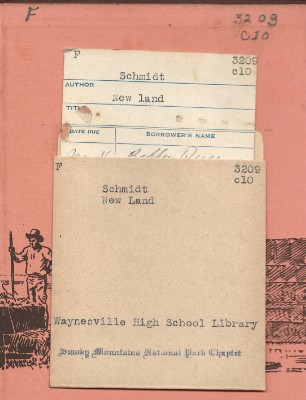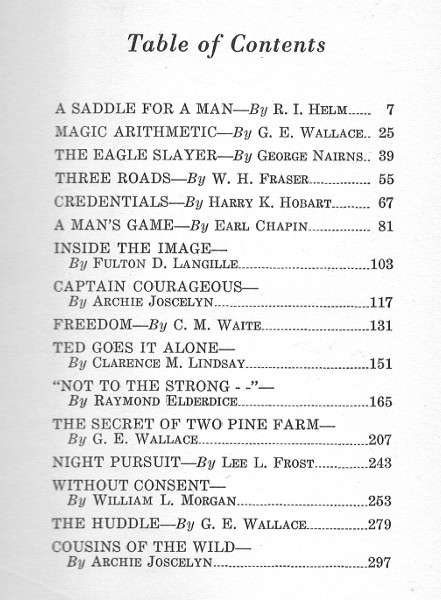“I can think of nothing finer for the organization than to create in its members a desire to read, and to guide members in the choice of good reading materials.”
The above statement was made by W. A. Ross, FFA Executive Secretary, at the 1940 National FFA Convention (p. 63). So, what constitutes “good reading materials?”
In last week’s Footnote we learned that having a FFA chapter library was a goal in the National FFA Organization’s Program of Work (POW) from 1936 To 1960. It was expected that the chapter library should have books on various agricultural subjects along with extension and experiment station bulletins plus an assortment of farm magazines. There should also be wholesome works of fiction
W. A. Ross provided additional suggestions as to what should be in the FFA chapter library, (1940 FFA Convention Proceedings, p. 63-64):
Historical materials gathered by members on old farms, ranches and plantations in the locality should, of course, become a part of the chapter library. While it is already quite well understood, I think that copies of the Proceedings of each national convention should always be an important book of any library.
The 1941-42 Program of Work suggested having an up to date FFA Manual and at least one book on parliamentary procedure in the chapter library.
So, what else should be in the library? How about books focusing on the FFA? The 1939-1940 National Program of Work specified that “Each chapter library to have at least one inspirational book on F.F.A.” The following year the number of books focusing on FFA in the POW was increased to five.
A question to ponder might be “How many books about the FFA existed in the early 1940s?’
Books Focusing on the FFA – circa 1940s
Following is a listing of books that one might want to include in the FFA library that are on the FFA. Which ones would be inspirational?
Table 1 FFA related books that existed in the early 1940s
| Publication Date | Title | Pages | Author | Publisher |
| 1925 | Tom of Peace Valley | 232 | John F. Case | Lippincott |
| 1929 | Future Farmers in Action | 115 | Arthur K. Getman | John Wiley & Sons |
| 1932 | Handbook for Future Farmers | 32 | Henry C. Groseclose | French-Bray |
| 1932 | The Green Hand | 230 | Paul Chapman | Lippincott |
| 1932 | Moon Valley | 291 | John F. Case | Interstate |
| 1933 | New Land | 317 | Sarah Lindsay Schmidt | Robert McBride |
| 1934 | Fun and Work for Future Farmers | 252 | L. L. Scranton | Interstate |
| 1936 | Short Stories for Future Farmers | 307 | Aretus W. Nolan | Interstate |
| 1936 | Ranching on Eagle Eye | 374 | Sarah Lindsay Schmidt | Robert McBride |
| 1939 | Forward FFA | 141 | William A. Ross | French-Bray |
| 1939 | Winning Future Farmer Speeches | 365 | Lyman S. Judson | Interstate |
| 1940 | Peace Valley Warrior | 330 | John F. Case | Interstate |
| 1940 | Shadow over Winding Ranch | 298 | Sarah Lindsay Schmidt | Random House |
| 1941 | Reporting FFA News | 248 | Charles E. Rogers | Iowa State Press |
| 1941 | Programs for Future Farmer Meetings | 310 | A. Webster Tenney | Interstate |
| 1941 | Practical Activities for Future Farmer Chapters | 318 | A. Webster Tenney | Interstate |
| 1942 | The F. F.A. Chapter: Its Organization and Activities | 80 | Embra Y. Noblin | Virginia Tech |
| 1943 | Public Speaking for Future Farmers | 364 | Lyman S. Judson | Interstate |
The first book in Table 1, Tom of Peace Valley, predates the FFA; so it is not an inspirational book about the FFA. However, it is an entertaining novel about a corn growing contest and vocational agriculture. A synopsis of this book was featured in an earlier Friday Footnote. A book review published in 1925 in The Unitarian Register called this book “spirited reading”. In a future Footnote we will learn more about the author, John F. Case, and the other books he authored listed in Table 1.
A review of Future Farmers in Action appeared in The Agricultural Education Magazine in December of 1929. The author was the state supervisor of agricultural education for New York. The intended audience for the book is FFA members. The review states (p. 13):
One of the great purposes of the Future Farmers of America is to learn to co-operate. This little book has been written to help you make the most of your opportunities in learning to work well together. There are 115 pages of sound counsel for Future Farmers. The style is one that should appeal to boys. Appropriate quotations from authors are used. Interest qualities are good.
Undoubtedly the most famous book from Table 1 is The Green Hand. It was made into a movie and shown in theaters all across the South. Refer to the October 5, 2018 Footnote to learn more about this book. The author was Dean of Agriculture at the University of Georgia. It might be the most inspiration book about the FFA on the list. And is interesting.
As the name implies the Handbook for Future Farmers is designed for organizing chapters of the Future Farmers of America and is a guide for officers and committees for carrying on chapter work. The original cost was 25 cents. Since Henry Groseclose was heavily involved in creating the FFA, he should know what he is writing about.
New Land is a juvenile novel about the benefits of agricultural education. Two 17 year old twins (Charley and Sayre) move to Wyoming from Chicago. Charley enrolls in the all-day agricultural education program while his sister, Sayre, convinces the agriculture teacher to let her enroll in the part-time program. The FFA is never mentioned in the story, but the value and importance of agricultural education is amply demonstrated. The book won a Newberry Award in 1934. A future Footnote will focus on the author, Sarah Lindsay Schmidt and her other agricultural education novels.

Figure 1. The checkout card for New Land from the Waynesville High School Library. Note – under the library name it reads “Smokey Mountain National Park Chapter.” That was the name of the FFA chapter in this high school in western North Carolina. The FFA library books were included as part of the school library.
L. L. Scranton was the state FFA advisor in North Dakota. Fun and Work for Future Farmers is a collection of games, programs, and community activities with practical ideas and suggestions for social and recreational programs. Scranton gives examples of what FFA chapters across the country are doing.
Short Stories for Future Farmers is a compilation of 16 short stories. A. W. Nolan, a teacher educator at the University of Illinois collected the stories from a variety of sources. In the introduction to the book he states:
…there has been a dearth of good books available for farm boys and girls. Here is a book filled with interesting stories, for the most part written by young people, and for young people on the farm especially.
Future Farmers of America everywhere are building up home and school libraries of good books, for wholesome recreational and instructional reading. This volume of short stories should find a welcome place in all Future Farmers’ homes

Figure 2. Table of Contents from Short Stories for Future Farmers
Forward FFA is a small inspirational book written by the FFA Executive Secretary, W. A. Ross. In the Preface Ross writes “This little volume includes inspirational and leadership development material used by the author, on various occasions, over a period of years. Frequent requests have been received for copies of certain passages and quotations.” To accommodate these requests, they were published in this book. The book was updated and revised in 1964.
As the title suggests Winning Future Farmer Speeches is a compilation of 48 winning state and national FFA speeches from 1938. Five years later the author, Lyman Judson, published a “how to” book on public speaking for FFA members. Judson was head of Auburn University’s Department of Speech and later moved to the University of Illinois.

Figure 3. Winning Future Farmer Speeches. 1939
Concluding Remarks
Over the past several decades there has been a call for schools to go “Back to the Basics”. Perhaps this might be a good idea for agricultural educators in regard to reading the books that were basic during the early days of the FFA and agricultural education. You might learn something new or be amazed at the wisdom of some of the early writers.
Every year at Christmas I buy myself a Christmas gift. This year you might want to gift yourself some of these agricultural education/FFA classics. Some are relatively inexpensive but a few of the rarer ones sell for hundreds of dollars. I patronize AbeBooks which is an online consortium of used book dealers. I often pick up books at a really good price.
It might be interesting to see how many of these books already exist in your professional or FFA library.
